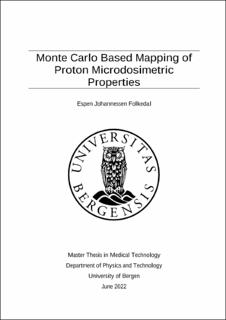Monte Carlo based mapping of proton microdosimetric properties
Master thesis
Permanent lenke
https://hdl.handle.net/11250/2999384Utgivelsesdato
2022-06-01Metadata
Vis full innførselSamlinger
- Master theses [85]
Sammendrag
Purpose: This study aimed to investigate the microdosimetric properties of monoenergetic proton beams. As the primary goal of radiation therapy is to inactivate cancer cells by damaging their DNA, the energy deposition distributions at nano- and micrometric levels may help increase our understanding of radiobiology, as well as improve RBE-modelling. Methods: In this project the GATE software was used to simulate particle tracks and energy depositions. The GEANT4 DNA physics list and the combination of Livermore and QGSP_BIC_HP were used and compared to one another. Monoenergetic proton beams of energies 1-100 MeV were simulated. Microdosimetric quantities were calculated for site sizes in the range 20 μm – 10 nm, and the results found in this work were compared to similar reported values in the literature. Results: A mapping of the frequency- and dose-mean lineal energy, y ̅_F and y ̅_D, as well as yd(y)-distributions for protons were calculated. The y ̅_D and y ̅_F-values were found to increase with both decreasing proton energy and site size. The yd(y)-distributions was found to broaden with both increasing proton energy and decreasing site size. The GEANT4 DNA yielded systematically lower y ̅_D-values compared to the Livermore + QGSP_BIC_HP combination, with the difference increasing with smaller site sizes. The y ̅_D-values from this work corresponded well with similar research. Conclusion: The results from this work could be used in investigating which site sizes that correlates best with the biological effectiveness of the proton beam. The field of radiobiology is complex and not understood fully, but microdosimetry could give a higher level of insight, and might improve modelling RBE.
